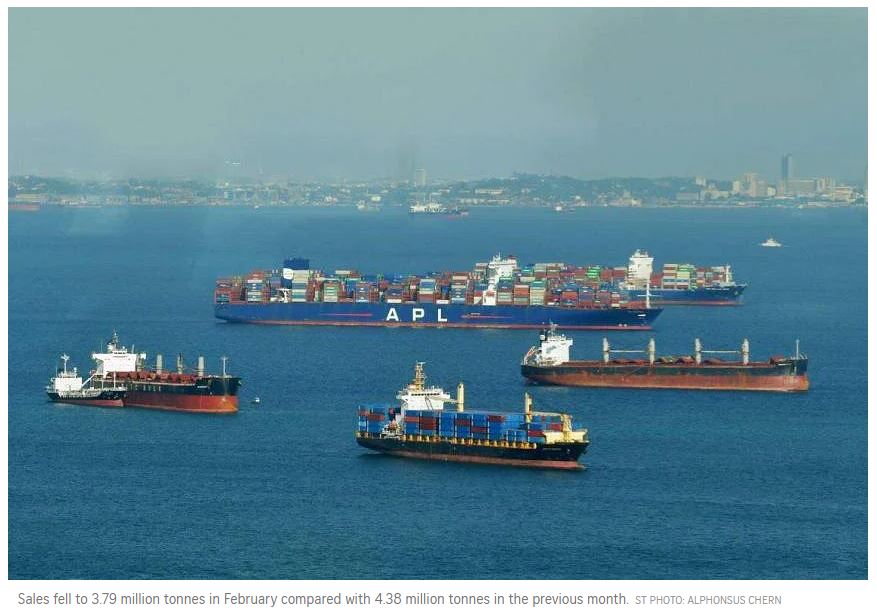Singapore bunker sales fall by 13.5% in February with outlook remaining weak
SINGAPORE – Marine fuel sales in Singapore contracted by nearly 13.5 per cent in February as fewer vessels called at the world’s largest bunkering hub due in part to the shorter month.
Sales fell to 3.79 million tonnes compared with 4.38 million tonnes in the previous month, data released by the Maritime and Port Authority of Singapore earlier this month showed.
A total of 3,424 vessels called to load bunker fuel here in February, a dip of nearly 6 per cent compared with January.
Mr Emril Jamil, senior oil analyst at Refinitiv, a unit of the London Stock Exchange Group, said the drops were a result of a combination of factors.
He said it was expected, with February being a shorter month, as well as because of the extended Chinese New Year festivities in Asia, which would have been factored into procurement programmes by shipowners.
“And then, on a fundamental level, all these coincided with contracting Chinese export activity,” said Mr Jamil.
Earlier this month, China trade data showed that exports fell by 6.8 per cent in combined figures for January and February compared with a year earlier, while imports dropped by 10.2 per cent.
Despite the month-on-month drop, marine fuel sales in February were more than 8 per cent higher compared with the same month in 2022.
Mr Jamil said: “Last year, at around the same time, we had events building up to the Russian invasion of Ukraine that pushed prices higher, and many shipowners hit the pause button to assess the situation before planning their procurement programmes.”
Sales of low-sulphur marine fuels at the port dipped close to 16 per cent in February compared with the previous month, while sales of the high-sulphur grade were found to be more resilient, contracting just under 10 per cent.
Mr Ivan Mathews, head of refining and global fuel oil service at consultancy FGE, said one of the reasons for the healthier demand for high-sulphur marine fuels was that it was still much cheaper to buy compared with the cleaner lower-sulphur option.
“Singapore remains the chosen bunkering port for vessels with scrubbers in Asia as there are many suppliers here offering high-sulphur bunkers,” he said.
Installing scrubbers, which extract harmful sulphur emissions, allows shipowners to meet environmental regulations while benefiting from being able to use cheaper high-sulphur fuels.
Mr Yaw Yan Chong, director of oil research at Refinitiv, said the pricing gap between high-sulphur and low-sulphur bunker fuels was still around US$130 to US$150 (S$172 to S$200) and that it was hard to see shipowners opting for the costlier fuel.
He added that the trend for 2022 was an overall increase of high-sulphur marine fuel sales in Singapore, while low-sulphur fuel purchases declined.
“There are more ships coming into the market with scrubbers and, because of that, we are going to see demand for high-sulphur marine fuels expanding,” said Mr Yaw.
Some traders whom The Straits Times spoke to said that recessionary fears could temper demand for marine fuel across all grades as shipowners scale back on marine fuel procurement.
“Container ships are already running at slower speeds to reduce their fuel consumption and this is the segment of the shipping market that typically reflects the health of the global economy, which is under severe stress at the moment,” said a senior trading manager, who declined to be named as he was not authorised to speak on behalf of his company.
“We are likely to also see demand for container vessels dip further as demand to move durable goods like computers and cars around the world contracts because consumers are more cautious about spending due to the uncertainty of the global economy,” he added.
Industry data showed that spot freight rates for a forty-foot equivalent container unit from China to the West Coast of the United States had dropped from around US$16,000 a day from a year ago to around US$1,000.
Source: https://www.straitstimes.com/business/s-pore-bunker-sales-fall-by-135-in-february-with-outlook-remaining-weak


 English
English




